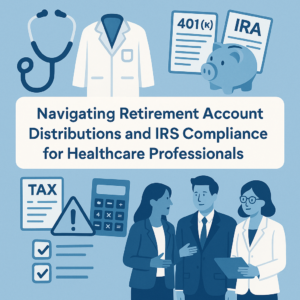Choosing the right retirement plan can be daunting given the variety of options available. Two popular choices are the Solo 401(k) and the SEP IRA. This blog post explores the differences between these two plans, highlighting key features such as higher contribution limits, Roth deferrals, and loan options. We’ll also discuss when each type of plan might be more beneficial for individuals close to retirement versus those with longer investment horizons.
Disclaimer: The information provided in this blog is for educational purposes only and not a substitute for personalized financial advice. It is important to consult with a qualified financial advisor to tailor advice to your specific financial situation.
Overview of Solo 401(k) and SEP IRA
The Solo 401(k), also known as an Individual 401(k), is designed for self-employed individuals with no employees other than a spouse. Key features include:
- Higher contribution limits: Up to $69,000 (2024 limits) if you are under 50, combining employee deferral and profit-sharing contributions.
- Roth deferral option: Contributions can be made on a pre-tax or Roth (after-tax) basis.
- Loan options: Allows loans up to $50,000 or 50% of your account balance, whichever is lower.
A Simplified Employee Pension (SEP) IRA is another retirement plan option for self-employed individuals or small business owners. Key features include:
- Simplified setup and administration: Easy to establish and maintain.
- Contribution limits: Up to 25% of net earnings from self-employment, up to a maximum of $69,000 (2024 limits).
- No Roth deferral option: Contributions are made on a pre-tax basis only.
Higher Contribution Limits
The Solo 401(k) offers higher contribution limits than the SEP IRA, making it an attractive option for those looking to maximize their retirement savings. Here’s how it works:
- Employee contributions: You can contribute up to $23,000 (2024 limits) or $30,500 if you’re age 50 or older.
- Employer contributions: Can contribute up to 25% of your net self-employment income. The total contribution limit for both employee and employer is $69,000, or $76,500 if you are 50 or older.
Advantages
- Flexibility: You can adjust contributions annually based on your earnings and financial goals.
- Catch-up contributions: Individuals over 50 can make additional contributions, boosting retirement savings as they approach retirement.
Example Scenario
Dr. Williams, a 45-year-old self-employed dentist, has a net self-employment income of $150,000. She can contribute $23,000 as an employee plus 25% of her income ($37,500) as an employer, totaling $60,500 in contributions in one year. Note the annual maximum is $69,000. If she increases her income, she can increase her total savings maximum in the Solo 401k.
The SEP IRA also has significant contribution potential but operates differently:
- Contribution rate: You can contribute up to 25% of your net self-employment income, with a maximum of $69,000 (2024 limits).
- Employer only: Only employer contributions are allowed; there are no employee deferrals.
Advantages
- Simplicity: Easier to calculate and administer for those who prefer straightforward plans.
- Cost-effectiveness: No additional filing requirements with the IRS, making it an economical choice for self-employed individuals.
Example Scenario
Dr. Brown, a 50-year-old self-employed physical therapist, earns a net self-employment income of $200,000. She can contribute 25% of her income, resulting in a $50,000 contribution to her SEP IRA. This straightforward approach simplifies her retirement planning strategy.
Roth Deferrals and Conversions
One of the appealing features of the Solo 401(k) is the option to make Roth deferrals. Contributions can be made on an after-tax basis, which allows for tax-free withdrawals in retirement.
Example Scenario
Dr. Carter, a 35-year-old psychologist, expects her income to increase significantly over the next decade. By contributing to a Roth Solo 401(k), she can take advantage of tax-free growth and withdrawals, which will be beneficial when she is in a higher tax bracket in retirement.
If your SEP IRA balance grows, you might consider converting it to a Roth IRA. This involves paying taxes on the converted amount now but allows for tax-free growth and withdrawals in the future. This can effectively be used to mimic the Roth option in a Solo 401(k).
When to Consider Roth Conversions
- Lower tax bracket: When you’re in a lower tax bracket, converting to a Roth IRA can minimize tax liability.
- Future tax planning: Allows for strategic tax planning, maximizing retirement income by potentially reducing future tax burdens.
Example Scenario
Dr. Taylor, a 40-year-old pharmacist, has accumulated a substantial balance in her SEP IRA. She plans to convert a portion to a Roth IRA in a year with lower earnings to minimize tax impact. This strategy will provide her with tax-free withdrawals in retirement, aligning with her long-term financial goals.
Loan Features
Solo 401(k) plans may allow for participant loans, up to $50,000 or 50% of your account balance, whichever is less. This feature can be beneficial for younger individuals who might need access to their retirement funds temporarily.
- Accessibility: Provides a way to access funds without incurring the early withdrawal penalty.
- Repayment to self: Loans are repaid to your account, so you are essentially paying yourself back with interest.
Risks and Considerations
- Repayment obligation: Loans must be repaid according to plan terms. Failure to repay can result in penalties and taxes.
- Opportunity cost: The borrowed amount could miss out on potential growth, affecting long-term savings.
Example Scenario
Dr. Green, a 32-year-old physical therapist, needs to access $30,000 for a down payment on a new home. A loan from his Solo 401(k) allows him to access these funds without the early withdrawal penalty, and he will repay the loan to his account, maintaining his retirement savings growth.
Practical Implications
Managing these retirement plans involves varying degrees of administrative effort. Understanding these implications can help in making an informed decision.
Solo 401(k)
- Paperwork and Filing: Solo 401(k) plans require filing annual IRS Form 5500 once the plan reaches $250,000 in assets.
- Cost: There may be setup and ongoing maintenance fees associated with managing a Solo 401(k).
SEP IRA
- Simplicity: SEP IRAs are easier to set up and have fewer administrative requirements.
- Cost: Generally lower administrative costs compared to Solo 401(k) plans.
Tax Planning Strategy
- Strategic contributions: Align contributions with years of higher earnings to maximize tax benefits.
- Roth Conversions: Execute Roth conversions during low-income periods to minimize tax impact.
- Diversification: Use a mix of pre-tax and Roth contributions to balance taxable income in retirement.
Comparing Benefits for Different Career Stages
Early Career Professionals
Solo 401(k)
- Higher savings potential: Young professionals can leverage high contribution limits to build substantial retirement funds early on.
- Loan access: Provides a safety net for unplanned expenses or investments in business opportunities.
- Roth contributions: Strategic Roth contributions during early-career can balance tax impact in retirement.
SEP IRA
- Simple setup: Helps new professionals establish a retirement plan with minimal hassle.
- Gradual growth: Allows contributions based on earnings, adapting to the career growth trajectory.
Mid-career Professionals
Solo 401(k)
- Increased contributions: Mid-career professionals often have higher incomes, enabling them to maximize Solo 401(k) contributions.
SEP IRA
- Ease of management: Continues to provide a straightforward retirement savings option, ideal for those with established routines.
Nearing Retirement
Solo 401(k)
- Catch-up contributions: Allows higher savings for those over 50, crucial for last-minute retirement fund boosts.
- Diversified tax planning: Combines pre-tax and Roth withdrawals to optimize retirement income.
SEP IRA
- Consistent contributions: Maintains a simple structure for continued savings until retirement.
The Role of Financial Advisors in Retirement Planning
Having a financial advisor can provide immense benefits:
- Tailored advice: Personalized strategies to match individual financial goals.
- Compliance: Assistance with legal and tax compliance, reducing the risk of penalties.
- Strategic planning: Guidance on optimizing contributions, Roth conversions, and withdrawals.
Choosing the Right Advisor
When selecting a financial advisor, consider:
- Credentials and experience: Ensure they are certified and have experience with retirement planning for healthcare professionals.
- Fee structure: Understand how they charge for their services, whether it’s a flat fee, percentage of assets, or commission-based.
Common Mistakes to Avoid in Retirement Planning
Mistake 1: Delaying Retirement Savings
Starting retirement savings late can severely impact the amount accumulated over time. Begin contributions early to take advantage of compound growth.
Mistake 2: Ignoring Tax Implications
Failing to consider the tax impact of contributions, Roth conversions, and withdrawals can lead to unexpected liabilities. Strategic tax planning is essential.
Mistake 3: Not Seeking Professional Help
Retirement planning can be complex. Not consulting a financial advisor might result in suboptimal decisions and missed opportunities for tax savings and investment growth.
Conclusion
Choosing between a Solo 401(k) and SEP IRA involves understanding your financial goals, expected income patterns, and retirement timeline. Each plan offers unique benefits and considerations:
Solo 401(k): Ideal for those seeking higher contribution limits, Roth options, and potential loans.
SEP IRA: Suitable for those who prefer simplicity, ease of management, and significant contributions without the need for additional features.
By understanding the distinctions and benefits of Solo 401(k) and SEP IRA plans, young healthcare workers can make strategic choices that enhance their financial security in retirement. Plan wisely, contribute effectively, and secure a financially stable future.







